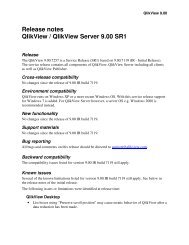effective cost modeling for service line planning - Wipfli
effective cost modeling for service line planning - Wipfli
effective cost modeling for service line planning - Wipfli
You also want an ePaper? Increase the reach of your titles
YUMPU automatically turns print PDFs into web optimized ePapers that Google loves.
departmentally focused. To identify growthopportunities, the provider typically per<strong>for</strong>ms amarket assessment that looks at <strong>service</strong> demandprojections, competitor strength, and physiciandemographics. The provider then benchmarks itsper<strong>for</strong>mance with a review of current marketshare, profitability, and <strong>cost</strong>s, while assessing avariety of internal metrics around quality, physicianleadership, and customer <strong>service</strong>.Set provider organizational strategy. With theinsights gained from the first step, the provider’sexecutive team typically analyzes the potentialimpact of each <strong>service</strong> <strong>line</strong> on the provider organization’soverall per<strong>for</strong>mance and prioritizes the<strong>service</strong> <strong>line</strong>s according to strategic objectives(e.g., “grow” or “protect” market share and, insome instances, even “exit the market”). Thisprocess allows the executive team to determinewhich <strong>service</strong> <strong>line</strong>s to pursue and in what order.The executive team can then begin to establishand communicate to management the strategicgoals and per<strong>for</strong>mance targets <strong>for</strong> the providerorganization.Implement the strategy. Management is chargedwith developing and enacting a plan to meet theidentified goals and targets. This ef<strong>for</strong>t mayrequire identifying specific improvement opportunities<strong>for</strong> existing <strong>service</strong> <strong>line</strong>s or launching anew <strong>service</strong> <strong>line</strong> that ideally can rapidly achievebest practice per<strong>for</strong>mance levels. Typically, severalstrategic options are identified and theimpacts of these options are assessed prior toimplementation.For instance, consider a provider organizationthat is evaluating growth options <strong>for</strong> surgical <strong>service</strong>s.Is growth limited by existing capacity andfacility constraints? If so, are there alternativesrelated to developing new surgical space or redeployingspace already existing in other parts of thefacility (e.g., relocating endoscopic <strong>service</strong>s to anadjacent medical office building in order to freeup scheduling problems in the surgical suites)?Once the strategic choices are made, an importantfocus <strong>for</strong> management becomes implementingA significant advantage of PBC <strong>modeling</strong>is that it can be used to model theentire provider organization, makingit possible to evaluate virtually allbusiness (and <strong>service</strong> <strong>line</strong>) opportunitiesusing a single tool.and monitoring action items to ensure successfuloutcomes. In the surgical <strong>service</strong>s example, thismay mean developing new or redeployed space,or the focus could be on process improvementopportunities such as improving turnaroundtimes, minimizing delays, and reducing case time.Manage and continuously improve <strong>service</strong> <strong>line</strong>per<strong>for</strong>mance. Once strategic options are implemented,success depends on the degree to whichthe provider organization continually strives <strong>for</strong>peak per<strong>for</strong>mance in its <strong>service</strong> <strong>line</strong>s. Ideally,managers will select and manage to the rightbenchmarks and metrics, continually adjustingoperations to ensure per<strong>for</strong>mance targets arebeing met.In each one of these steps, PBC <strong>modeling</strong> cancontribute essential in<strong>for</strong>mation in a wayunmatched by other tools and techniques, makingit an essential tool <strong>for</strong> successful <strong>service</strong> <strong>line</strong><strong>planning</strong>.The Advantages of PBC ModelingA healthcare provider’s ability to accomplish thefour basic <strong>service</strong> <strong>line</strong> <strong>planning</strong> steps depends onhow well it delivers the right financial in<strong>for</strong>mationto understand the <strong>service</strong> <strong>line</strong>, and how wellit can per<strong>for</strong>m accurate, real-time analytical<strong>modeling</strong> of strategies, strategic options, andper<strong>for</strong>mance. Financial tools that healthcareproviders typically use <strong>for</strong> such ef<strong>for</strong>ts tend to beinadequate, often because in<strong>for</strong>mation is lackingsufficient accuracy or precision, or <strong>modeling</strong> isnot in real time.II MAY 2010 healthcare financial management
















